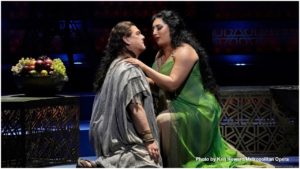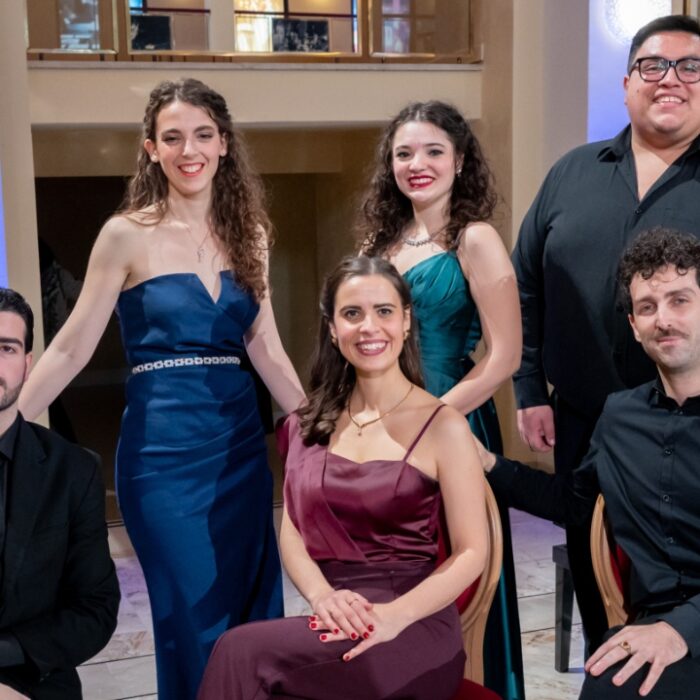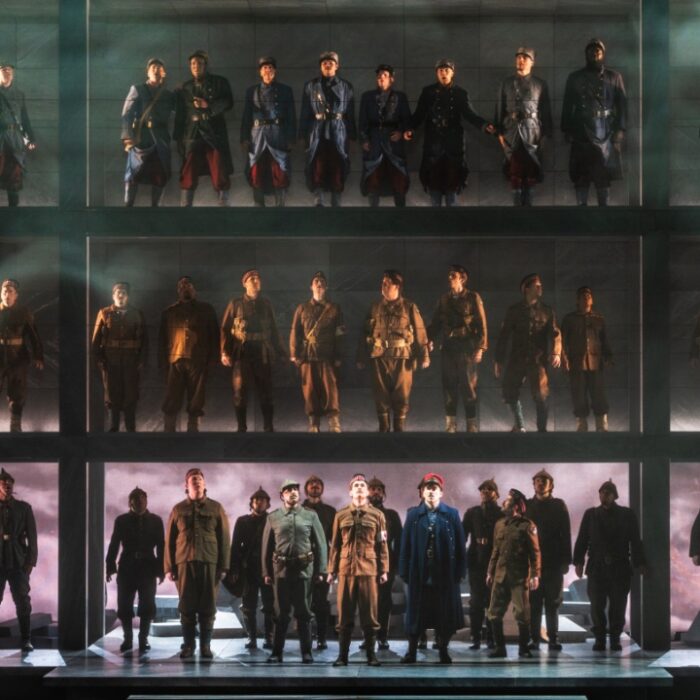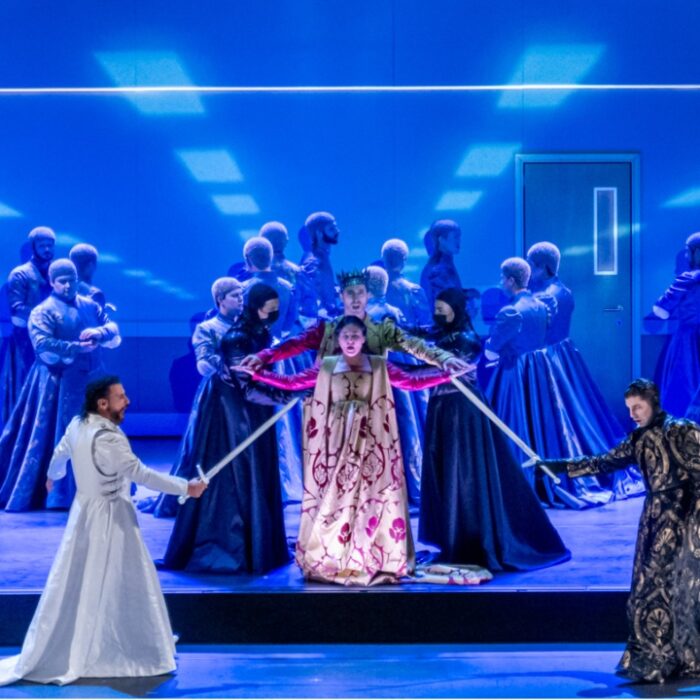
Metropolitan Opera 2018-19 Season Review: Samson et Dalila
A Tale of Two Tenors as Gregory Kunde Makes Long-Awaited Return to Met
By Logan MartellOn March 14, 2019, the Metropolitan Opera raised the curtain on the next run of performances for its new production of Saint-Saens’ “Samson et Dalila.” Darko Tresnjak’s vision of ancient Israel is one that is both strange and stunning. While there is much to be savored visually, many aspects overplay certain elements of the opera, while not giving their due to others. Despite this, Wednesday’s performance held a number of surprises, one of which has already made headlines after leaving audiences abuzz.
Points Aplenty
When the curtain rises and the show begins, there is a screen dotted with holes, which covers the set and performers during the overture and carries into the chorus of enslaved Israelites. While deliberately obscuring, this screen seemed to act as a filter, and its use in certain moments gave to the stage the appearance of a painting made using pointillism. While the costumes favored a more traditional approach, the set itself showed influences of an almost primitive sci-fi aesthetic. This was mainly felt due to the strong presence of different kinds of metallic grates and meshes, as well as the red neon ring, which makes something of a portal into which the audience sees these dramatic events unfold.
The first Samson of the evening was tenor Aleksandrs Antonenko, who made his entrance between from the crowd of wailing Israelites; the neat parting of their arrangement seemed to imply they were waiting on a savior to arrive. Antonenko’s bear-like physique gave him a presence which was greatly complimented by his strong, pious tones in the exhortations he used to rally the Israelites. Before the oppression of Abimelech, played by Tomasz Konieczny, Antonenko carried himself with a defiant, almost swaggering posture that was finely contrasted by the beating of the orchestral harps.
Saving the Hero
As the first intermission ended, it was announced that Antonenko had to withdraw due to illness. Filling the role of Samson was revered tenor Gregory Kunde, whose name sent an excited murmur through the audience. When Kunde’s Samson emerged for his fatal rendezvous with Dalila, the dramatic tenor quickly displayed a clear and charged quality of voice that shone all the more when his lines turned to Samson’s God-given duties. As he is captured by the Philistine soldiers, the dotted screen fell and lent its pointillist filter to this powerful moment of betrayed love and downfall. This downfall also found expression in how Kunde delivered phrases such as “Mortal anguish floods my guilty heart!” with blaring and tragic vocal colors.
On the matter of Biblical feats, the climactic scene with Samson breaking the pillars of the temple also saw much influence from Tersnjak’s stunningly strange artistic vision. Here, the pillars were the left and right portions of a massive human figure split cleanly in two. Presumably, this figure is meant to be Dagon, though its only features are its sheer size and metallic rings. The symbolic importance of this oddly-fabulous golem, however, soon became clear; just as Samson, blinded and weak, offered his broken self in supplication to God for one final miracle, God granted him the strength to use the broken man of the statue of Dagon to reduce the temple to rubble. Running with this interpretation, I was rather let down that the statue halves did not budge, much less collapse. While one can easily infer the collapse of the temple due to the orchestral swell and overwhelming light that illuminates from behind Samson, the sudden freeze of the performers, or at least Samson, created a tableau effect that while striking, was highly anticlimactic.
A Dark Triumph
Opposite Antonenko and Kunde was mezzo-soprano Anita Rachvelishvili in the role of Dalila. Making her entrance with regal bearing, Rachvelishvili’s opening lines were handled with an endearing gentleness; a vocal façade that would later be done away with entirely.
For all the pageantry within the costumes and designs there was an elevation of Dalila into a blatantly regal figure, making one wonder her exact position and status in relation to Samson and the other Israelites. This Dalila seemed closer to the title roles of operas such as Mayr’s “Medea in Corinto,” or Goldmark’s “The Queen of Sheba.” This impression came strongly in Dalila’s entrance and initial seduction attempt in Act one where her retinue of dancers and plume-bearers improvise a throne by placing a gold stool above a silk on the floor, before flanking the sitting Dalila with an array of feathers. Though I did like the execution of this and other choices, the overall portrayal of Dalila seemed to take away from her character; it’s only natural for the strongest man to fall to the charms of the most beautiful and luxurious woman, but Dalila’s identity as something of an everywoman is what, in my opinion, makes her taming and breaking of Samson into such a Biblical feat.
These incongruences, however, were smoothed out by the sheer dramatic and vocal fire Rachvelishvili brought to her interpretation. Her Act two aria “Amou! Viens aider ma faiblesse,” saw a delightfully wicked disconnect from her earlier cloying, as she darkly ruminated over a brazier. With her thoughts on her own power she sustained the phrase “but I alone can face him,” before ending with a burst of haughty ornaments. Her duet with Laurent Naouri’s High Priest of Dagon, “Il fout, pour assouvir ma haine,” gave plenty of time to explore these dark motivations. One notable direction saw them stick their hands over the fires of the brazier to illustrate their joining into a pact to bring down Samson; Rachvelishvili takes Naouri by the wrist and pulls his hand deeper into the fire as if demanding more of his loyalty as she leads him into eventual ruin.
Tainted Love
When Kunde’s Samson finally entered, Rachvelishvili mixed her vocal sweetness with Dalia’s underlying current of malice, making it well-suited for manipulative phrases such as “I have only drunk poison in your intoxicating embrace,” as the orchestra tapered to leave only her scalding tones. For her aria “Mon coeur s’ouvre a ta voix,” Rachvelishvili’s disrobing was a sensual contrast to her disguised intentions as her lines urged Samson to increasing heights of love. This sense of fierce romance was also reflected by the sweet orchestral bloom set to the phrase “an arrow is less swift to convey death.” Kunde’s repetitions of “je taime,” said much of his failing defenses, with one repetition peaking feverishly halfway through. Her dismissal of his frantic love clipped off with a spoken quality of voice as if she were wiping her hands of all the intimate tones she had been indulging him in.
Speaking of having to wipe one’s hands, the statue of Dagon also saw use for Act three’s Bacchanale, as semi-nude servants writhed and swung from its glowing recesses. The choreography for this famous scene employed feral spins, crawling, and all manner of lusty thrusting that seemed rather incomplete given the absence of women in the first half. When they did join in, the music took on more elegant hues which spiced up further thanks to the oriental scale used by the woodwinds, and finally, the massive percussion which drives the orgy to a profane climax.
Wednesday’s performance had much to be excited about, from the gradient beauty of Tresnjak’s production, to the unexpected entrance of Gregory Kunde; while the evening was brought to a powerful conclusion, there was a sense of dragging on as the opera ended roughly twenty minutes past schedule. The two intermissions lasted about a half hour each, but before the curtain could rise on the third act a number of audience members got up and left, with at least one voicing her concern over being able to secure reliable transportation. Beyond these minor bumps, this season’s run of “Samson et Dalila,” is sure to thrill audiences. It has been announced that Gregory Kunde will be covering the remaining performances of this run as Antonenko recovers. This dramatic jolt may well prove to turn a rather uneven production into a highly unforgettable experience.


